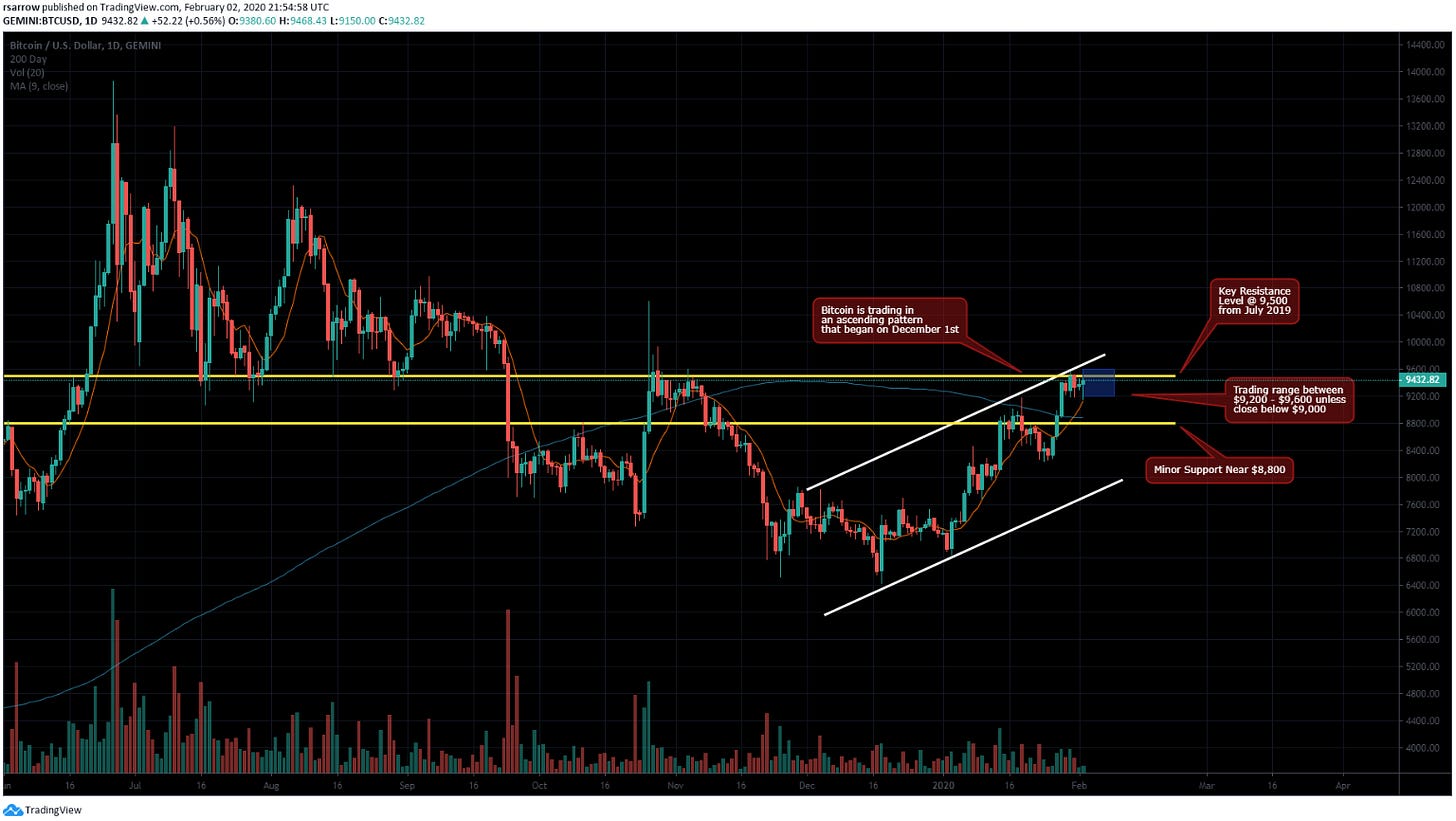Week of 1.26.20 - Issue #13
Welcome to the 13th edition of the ₿it Economy! Intro is a little longer this week as I have an announcement to make. In the coming week, I will be joining Digital Asset Research as a Research Analyst. Over the last two years, I have meticulously followed this industry everyday, often resulting in long nights learning about "magical internet money.” The countless hours have paid off and after meeting with the team, I could not be more excited to start full-time in cryptocurrency with DAR. I am excited to share with you in the coming months everything that DAR has to offer to the cryptocurrency ecosystem. But do not worry, I will still be breaking down the top stories in Bitcoin in a clear and simple format. Enjoy!
Topics: LN Strike & CoinJoin Wars
The Brief:
Jack Maller and the Zap team announced Strike, an application that allows one to make Lightning payments with your debit card or bank account. A pseudonymous account gets questioned for CoinJoin usage. And finally, we have a packed Reads and Listens section for this week and I want to make special note of Peter McCormack's 9-part Beginner's Guide to Bitcoin. This series is an excellent starting point for those who want to learn about Bitcoin from key individual in the ecosystem and I highly recommend you listen to them all.
S1: LN Strike
What is it? - Zap, the Bitcoin Wallet developer has released a new application called strike. The app allows customers to make payments on the Lightning Network using just a debit card or bank account. The technology was built on top of its Olympus product in order to create a seamless fiat-to-Lightning gateway. The app, released by Jack Mallers, standardizes payments globally by allowing users to connect a bank account and pay any Lightning invoice. In order to operate Strike, Zap have partnered with liquidity providers and banking partners to handle the requests generated from the application.
Why it Matters? - This is one of the biggest things to happen to bitcoin in the past year. Applications like Strike fight for the following:
A state financial surveillance used to map and/or control citizen behavior
Surveillance capitalism, where companies monetize your transnational data
The application enables the Lightning Network to be the world’s global payment system. Merchants are now able to operate without the worry of chargeback risk. Any bitcoin received over the LN can be converted back to fiat with a small exchange fee. Zap holds the USD deposits with an FDIC banking partner built on top of its infrastructure product Olympus. Olympus reduced friction in onboarding bitcoin to the LN but was unable to address adoption. The opportunities with this development are endless, where the Olympus infrastructure reduces friction among users by allowing them to seamlessly move value across networks for various payments.
Final Take - Services like Strike enable lower the adoption barriers for retail users and merchants.
S2: CoinJoin Wars

What is it? - Paxos, the issuer of the PAX stablecoin, is a regulated financial institution building infrastructure to enable movement between physical and digital assets. However, they are in the news this week for their recent notice to the pseudonymous account @RonaldMcHodled. where they discourage the use of Bitcoin mixing services. As a reminder, CoinJoins are a trustless method for combining multiple Bitcoin payments from multiple spends into one single transaction to make it more difficult for outside parties to determine which spender paid which recipients. For more, checkout Issue #5 where I covered a Wasabi Wallet upgrade. Over the past few months, the battle for user privacy has heated up. Bitcoin and other cryptocurrency trading platforms are succumbing to pressure from governments to comply with strict AML and know-your-customer (KYC) regulation. For example, in Europe, companies like Bottle Pay were forced to pivot due to 5th Anti-Money Laundering Directive (AMLD5) where institutions are forced to discourage mixing activity in order to comply with potential money-laundering issues. In response, the firm released the following:
"Sorry if we were unclear. We wouldn’t necessarily outright deny service to someone who has used a mixer, but we do monitor for alarming patterns. As a regulated financial institution, it is within our responsibility to ensure that our customers are not engaged in money-laundering or other illicit activities. We do our best to follow AML/KYC standards for this type of institution."
Why It Matters? - The fight for privacy against institutions surveilling our everyday financial transactions continues to escalate. This is not the first time an exchange has flagged a transaction, and it certainly will not be the last. Exchanges like Paxos and Binance, have been increasing their surveillance methods as well as implementing stricter to KYC policies while companies like Chainalysis and Elliptic make mixer usage easily to track. Platforms like exchanges are attempting to remain as regulatory-compliant as possible in an ever-changing landscape. The goal of a CoinJoin is to delink a UTXO's past from its future where the outputs amounts must be equal. Firms like Paxos ban mixing services in order to prevent any attempted money laundering. However, this news is more likely to spark outrage across the pro-privacy community. If one were to take out cash out of an ATM, and then swap the bills with the same amount of value with a stranger. During this exchange, a banker pops out of nowhere and tells you that the transaction is not valid. In this case, the role of the banker is Paxos. As for now, the batching process is one of the most secure and efficient use cases for Bitcoin. Moreover, users have the following options to combat this censorship:
CoinJoin and Opt-Out of Exchanges
CoinJoin and Continue using Exchanges
Stop CoinJoining
One should employ privacy measures like CoinJoin in every transaction in order to maximize the fungibility of their respective UTXO's.
Final Take - The next Bitcoin battle will be over privacy.
Market Watch
- High: $9,505.18
- Low: $8,338.34
- ATTOW: $9,428.31
Bitcoin registered its best January price gain in seven years thanks to the rally earlier in the week. The increase was extremely positive for Bitcoin as the bulls were able to break above the yearly high of $9,198. This breakout confirmed a wedge breakout as the asset approached the 200-day MA. Subsequently, the following two days saw the digital asset post consecutive days of gains, settling just above $9,300. This can be attributed to a bullish Marubozu Japanese candlestick pattern that appeared on January 27th. This pattern is a long green candle, with little to no upper or lower shadows which shows that buyers controlled the trading day from open to close. However, a tug of war between the bulls and the bears occurred for the remainder of the week with the price posting an intraday high of $9,431 on Wednesday. However, it appears that bulls may face minor resistance at $9,600 and psychological barrier near $10,000. If the asset were to close above five-figures, it would be a huge mental win for those who want the value to increase. If the price were to dip below the 200-day MA, a further pullback cannot be ruled out.

Announcements
- New Sparkswap version available - Link
- Phoenix Wallet 1.1.0 release - Link
- City of Zermatt, Switzerland Accepts Tax Payments in Bitcoin - Link
Interesting Reads
- Bitcoin: The Blockchain for Truly Smart Contracts - Link
- Bitcoin Optech Newsletter #82 - Link
- Bitcoin Obsoletes All Other Money - Link
- How Many Entities Hold Bitcoin? - Link
- Dollars in Barrios Are Note a Privilege Anymore - Link
- How Will You Measure Your Life - Link
- Ring Doorbell App Packed with Third-Party Trackers - Link
- Wawa's Massive Card Breach - Link
- Being a Noob - Link
Great Listens
- The Beginner's Guide to Bitcoin Part 1: Why We Need Bitcoin w/ Andreas M. Antonopoulos - Link
- The Beginner's Guide to Bitcoin Part 2: What Is Money w/ Parker Lewis - Link
- The Beginner's Guide to Bitcoin Part 3: Pre-History and the Cypherpunks w/ Aaron Van Wirdum - Link
- The Beginner's Guide to Bitcoin Part 4: What is Bitcoin w/ Stephan Livera - Link
- The Beginner's Guide to Bitcoin Part 5: The History of Bitcoin w/ Marty Bent - Link
- The Beginner's Guide to Bitcoin Part 6: How Bitcoin Works w/ Shinobi - Link
- The Beginner's Guide to Bitcoin Part 7: Bitcoin's Monetary Policy w/ Dan Held - Link
- The Beginner's Guide to Bitcoin Part 8: How Bitcoin is Legal w/ Peter Van Valkenburgh & Jerry Brito - Link
- The Beginner's Guide to Bitcoin Part 9: Altcoins, A History of Failure w/ Nic Carter - Link
- Tales from the Crypt #131: Matt Corallo & Valentine Wallace - Link
- Tales from the Crypt #130: Jeremy Rubin - Link
- Stephan Livera Podcast #144: Steve Lee - Link
- Presidential Candidate Andrew Yang on Bitcoin & Cryptocurrency - Link
Final Quote
"You still have a chance to front-run the Bull. Do not forsake your descendants." - Michael Goldstein, President of the Satoshi Nakamoto Institute and co-host of the Noded Bitcoin Podcast
Due to the career move, I will be taking a one-week hiatus from the ₿it Economy. Expect Issue #14 on February 16th. Have a great two weeks!


